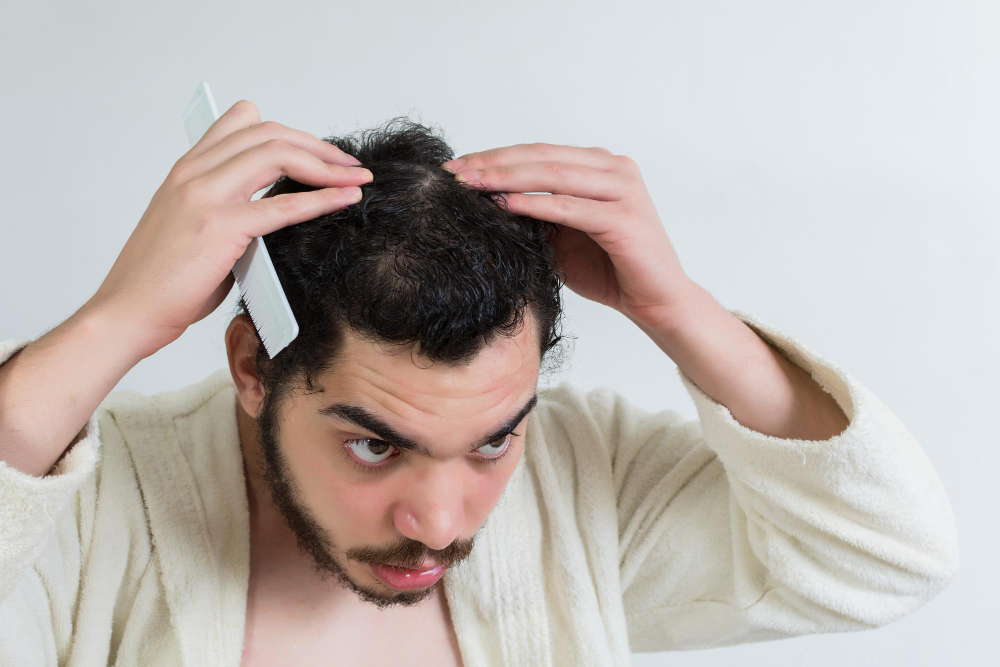Attention-deficit/hyperactivity disorder (ADHD) is increasingly diagnosed in both children and adults, and the use of medications such as stimulants (methylphenidate, amphetamines) and non-stimulants (atomoxetine, guanfacine) has risen globally. While these medications are highly effective in managing ADHD symptoms, there is a growing discussion about their impact on hair health. Patients and clinicians alike have observed cases of hair thinning, increased shedding, and telogen effluvium associated with certain ADHD medications.
ADHD Medication and Hair Loss
The relationship between ADHD medication and hair fall appears to be multifactorial.
- Stimulant medications, such as methylphenidate and lisdexamfetamine, can contribute to nutrient depletion (iron, zinc, vitamin D, folate) due to appetite suppression, which is critical for healthy hair cycling (Ramírez-Marín et al., 2025).
- Atomoxetine, a non-stimulant, has been linked in case reports to diffuse alopecia, thought to be a side effect of altered neurotransmitter signalling affecting follicle cycling (Donnelly et al., 2024).
- Additionally, ADHD medications may indirectly exacerbate hair loss by increasing stress, poor sleep, or dietary restriction, all of which are established triggers for telogen effluvium.
Although the incidence of ADHD medication–induced hair loss is relatively low, it can be distressing for patients and often complicates concurrent management of conditions like androgenetic alopecia or alopecia areata.
PRP Therapy and ADHD Medication: Is There an Interaction?
Platelet-rich plasma (PRP) has become an established regenerative treatment for both male and female pattern hair loss. PRP works by delivering concentrated platelets and growth factors (VEGF, PDGF, IGF-1, EGF) directly into the scalp to stimulate follicle regeneration, angiogenesis, and prolongation of the hair growth phase.
The available evidence (Zhang et al., 2025; Donnelly et al., 2024; Raja et al., 2025) strongly supports PRP as effective for androgenetic alopecia and increasingly as an adjunct in alopecia areata. However, there is no direct pharmacological interaction between ADHD medications and PRP efficacy reported to date. The main concern lies in secondary effects:
- Nutrient Deficiency: If ADHD medication leads to poor nutrition and low micronutrient levels, the follicles may be less responsive to regenerative signals from PRP.
- Stress and Cortisol: Chronic stress associated with ADHD and stimulant use can increase scalp inflammation, which may blunt PRP’s regenerative capacity.
- Sleep Disruption: Stimulant-related insomnia is another indirect factor that worsens hair shedding and may reduce optimal PRP outcomes.
Encouragingly, clinical reviews of PRP in 2024–2025 consistently demonstrate that PRP remains effective in most patients, provided that underlying triggers such as medication-induced deficiencies or lifestyle stressors are identified and managed (Wiley, 2025; Actas Dermosifiliográficas, 2024).
Practical Guidance for Patients
For individuals on ADHD medication considering or undergoing PRP, the key is a holistic approach:
- Consultation and Screening: Assess for micronutrient deficiencies (iron, vitamin D, zinc, folate) before starting PRP.
- Nutritional Support: Dietary optimisation or supplementation can mitigate medication-related hair shedding.
- Integrated Planning: Collaboration between psychiatrists and hair specialists ensures continuity of ADHD care while addressing hair loss concerns.
- Monitoring: Track hair density and shedding patterns after initiating or changing ADHD medication, particularly in the first 6–12 months.
At present, ADHD medications do not contraindicate PRP therapy, but they may require closer monitoring and supportive measures to achieve optimal results.
References
- Ramírez-Marín, H.A., Valdez-Zertuche, J.A., et al. (2025). Efficacy, safety and tolerability of drugs for alopecia: a comprehensive review. Expert Opinion on Drug Safety. Link
- Donnelly, C., Minty, I., Dsouza, A., Wong, Y.Y. (2024). The role of platelet-rich plasma in androgenetic alopecia: a systematic review. Journal of Cosmetic Dermatology. PDF
- Raja, H.A.A., Fazal, F., Mumtaz, H. (2025). Comparison of PRP with topical minoxidil in treating androgenetic alopecia: a systematic review of clinical trials. Skin Health and Disease. Link
- Zhang, G., Song, Y., Zhuang, T., Zhao, Y., Pan, Z. (2025). Clinical application and research progress of platelet-rich plasma. Hematology.
- Panchaprateep, R. (2024). Medical treatment for androgenetic alopecia. Facial Plastic Surgery.
- Abarca, Y.A., Scott-Emuakpor, R., Tirth, J. (2025). Alopecia areata: understanding pathophysiology and treatment advances. Cureus. PDF
- Xue, P., Guo, L., Dang, E., Dou, W. (2025). Prospective study of PRP in hair transplantation for AGA. Journal of Cosmetic Dermatology.
- Vargas, E.J., Muñoz, A.L., Gómez, L.A. (2024). Platelets as regenerative cells: hundreds of opportunities in sight. OBM Transplantation.
- Xiao, R., Lee, L.N. (2024). Updated review of androgenetic alopecia treatment. Facial Plastic Surgery Clinics.
- Sun, Y., Lu, M., Gao, X., Liu, Y., Ren, J. (2025). Bibliometric analysis of androgenetic alopecia treatment research. Journal of Cosmetic Dermatology.

